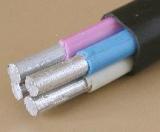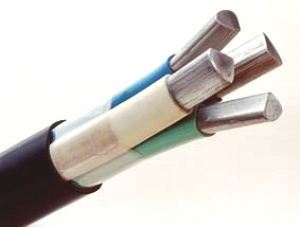Technical characteristics and installation methods of the AVVG cable
 AVVG — cable consisting of aluminum conductors, flexible, each conductor is protected by an insulating layer of polyvinyl chloride material, in addition, the cable itself has a protective outer sheath consisting of a PVC compound.
AVVG — cable consisting of aluminum conductors, flexible, each conductor is protected by an insulating layer of polyvinyl chloride material, in addition, the cable itself has a protective outer sheath consisting of a PVC compound.
Due to its low price and excellent quality, the AVVG cable has established itself as the best conductor for industrial, warehouse, residential residential buildings in lighting networks, internal wiring, as well as an input cable for switchgear.
The cores of the AVVG cable are made of soft types of aluminum, which makes it more flexible in operation, but also fragile if installed incorrectly. There are two types of conductors: round and sector. Depending on the application, the cable core is produced as single-wire or multi-wire with multiple cross-sections in accordance with GOST.
The AVVG cable is designed directly for the transmission and distribution of electricity with a voltage of 660 and 1000 volts AC and a frequency of 50 Hz. The temperature difference ensuring the normal operation of the cable is from –50 ° C to + 50 ° C.The maximum permissible heating of the cable core should not exceed + 70 ° C, without taking into account the heating time. Although in an emergency situation, the core of the AVVG cable is able to withstand heating up to + 80 ° C.
The permissible temperature range for cable installation varies from –15 ° C to + 50 ° C. At an ambient temperature below 15 ° C, pre-heating of the cable is required.
In the process of installing the cable on bends, descents, ascents, it is necessary to observe its bend. To avoid damage to the cable, the bend should be 10 diameters for single-core and 7.5 for multi-core diameters. With proper installation and operation of the cable, the service life is 30 years.

AVVG cable
Ways to install AVVG cable
1. Hidden cable:
Hidden cable routing is the safest and most aesthetic type of installation. The cable is laid in cavities, channels, ducts on surfaces of non-combustible or hard-to-burn materials with subsequent sealing of these places and does not require additional protection. For hidden installation in easily flammable structures, additional protection is required - asbestos pipes, metal pipes, metal hose, etc. Protection from PVC materials for this type of cable is undesirable.
2. Open the cable routing:
The open laying of the AVVG cable is carried out on the surfaces and ceilings of rooms that do not support combustion and do not have the possibility of mechanical damage to the cable. Installation is carried out taking into account all the rules of PUE and SNiP. Open laying on combustible surfaces using specialized protection such as electrical conduits, metal hose is also acceptable for AVVG cable. PVC protection is not allowed for this type of installation.
The surface mounting method also includes running cables through trays, cable channels, ducts. At the same time, the parameters for the installation of structures are selected based on the design of the premises where the cable will be laid; environmental factors in which the cable will be used are also considered. When installing the cable in an exposed manner from building to building, it is possible to top mount the cable on cables selected according to the cable's own characteristics and withstand tension, cable weight, sag boom, ice, etc.
3. Laying in the ground:
AVVG cable, like many other cables, is not recommended for laying in trenches and soils. AVVG does not have its own protection against mechanical stress on the cable sheath, which in further work leads to cable damage.
When you install, you should use Rules for Electrical Installation (PUE), as well as construction norms and rules (SNiP).
